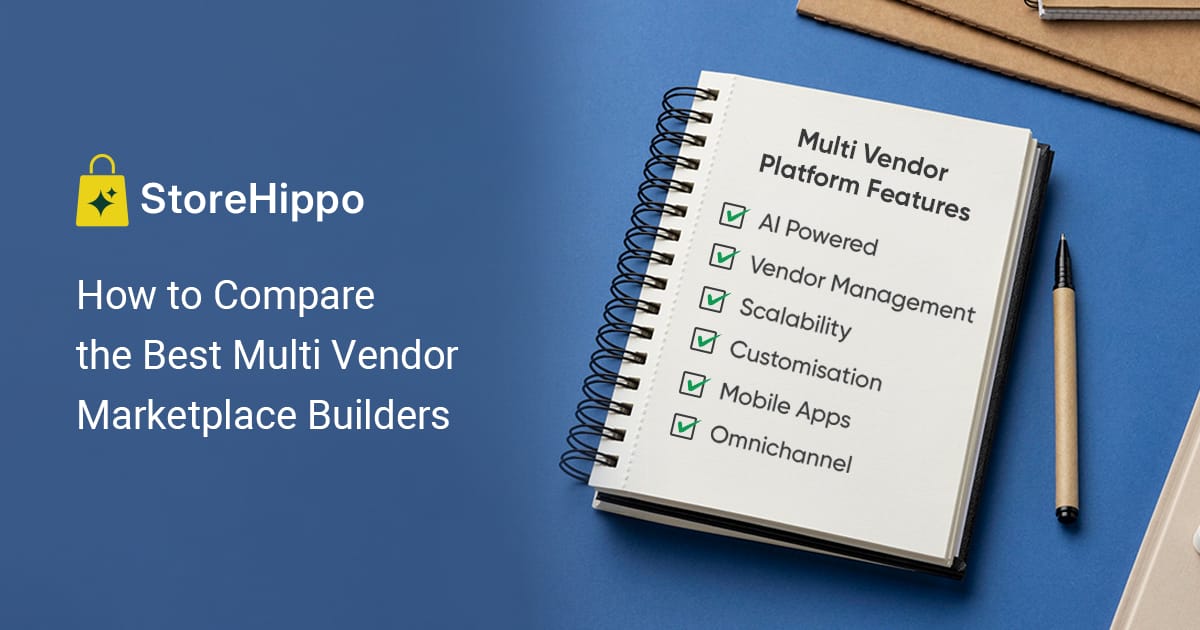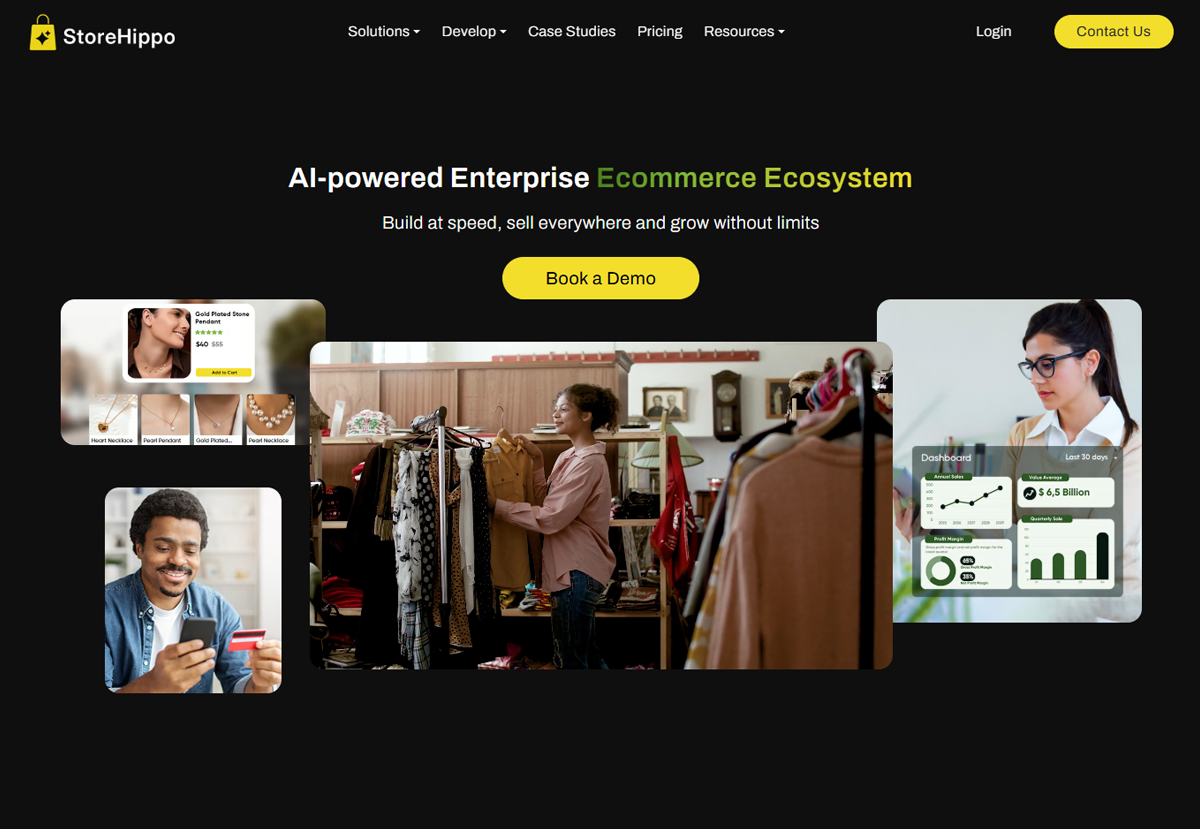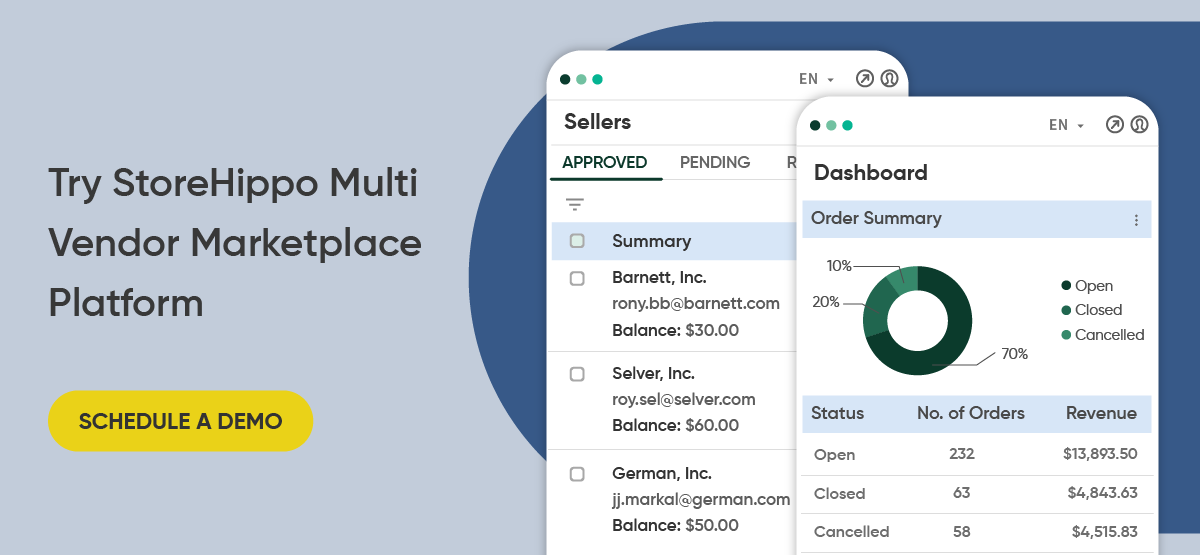Multi Vendor Marketplace is the model for ecommerce success.
If the astounding growth and success of the multi-vendor marketplace model has you searching for the best platform to power your business, you’ve landed on the most detailed and future-ready comparison guide available.
This blog not only helps you compare and choose the best multi-vendor marketplace platform, but also answers key questions on business models, solution providers, and future trends. So let’s start with the latest market insights before diving into platform features.
Table of Contents
- Why Enterprises Should Go For The Multi Vendor Marketplace Model
- 10 Best Multi Vendor Marketplace Platforms In 2026
- What is a Multi Vendor Marketplace Platform?
- How are Multi Vendor Ecommerce Platforms Different from Regular Ecommerce Solutions?
- Must-Have Features of a Multi-Vendor Marketplace Software
- Must-Have Multi Vendor Marketplace Software Features For The Administrators
- Must-Have Marketplace eCommerce Software Features for the Vendors
- Must-Have Multi Vendor Ecommerce Software Features for the Customers
- Top Multi-Vendor Marketplace Software in 2026
- 1. StoreHippo Multi Vendor Marketplace Platform
- 2. BigCommerce Multi-Vendor Solution
- 3. Magento Marketplace Extension
- 4. Shopify Multi-Vendor Plugin
- 5. Shift4Shop (Earlier 3dcart) Marketplace
- 6. Yo!Kart Multi-Vendor
- 7. CS Cart Multi-Vendor Software
- 8. Mirakl Multi-Vendor Marketplace
- 9. Marketplacer Multi-Vendor Marketplace
- 10. IXXO Multi-Vendor Marketplace
- How to Choose the Right Multi Vendor Marketplace Platform for Your Business
- How to Build a Marketplace Website?
- How to Promote your Multi Vendor Marketplace Business?
- Why Multi Vendor Marketplace is the Best-Fit Model for Your Enterprise Business?
- Why Multistore Marketplace Website Model is Good for Taking Your Enterprise Business to International Markets?
- Choosing The Best-Fit Multi Vendor Marketplace Platform For Your Business
- FAQ
Why Enterprises Should Go For The Multi Vendor Marketplace Model
The success of the multi-vendor marketplace model is evident in the numbers, clear indicators that it is rapidly becoming the preferred choice for buyers across industries and business models.
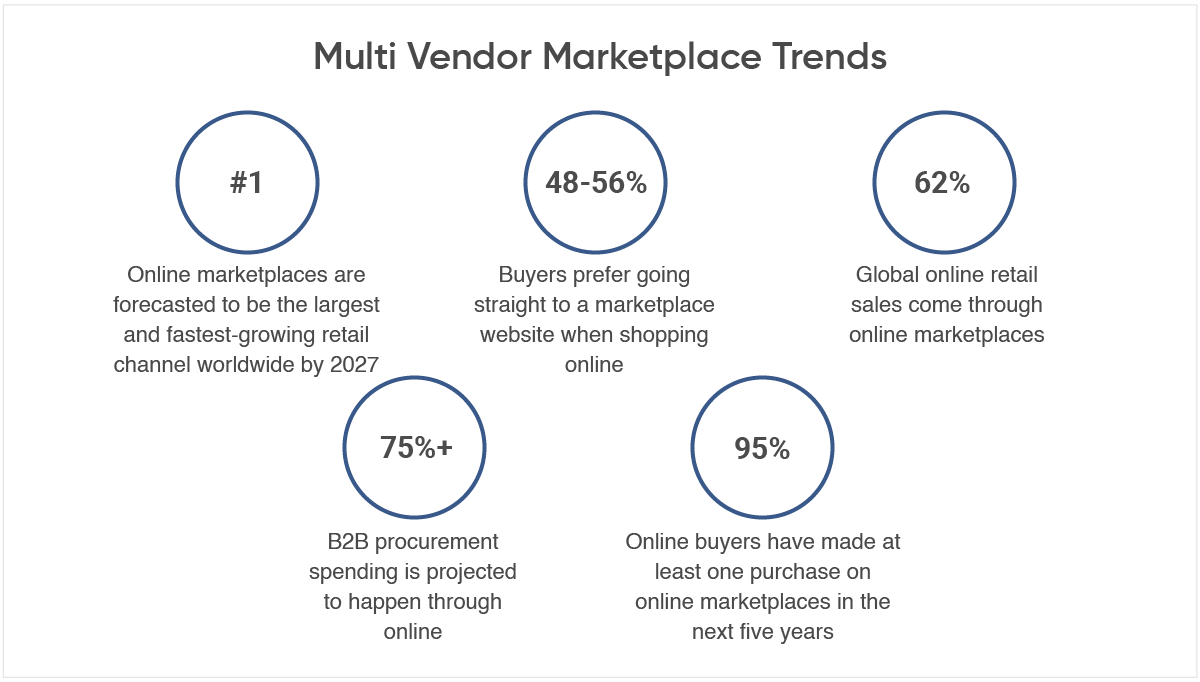
- #1- Online marketplaces are forecasted to be the largest and fastest-growing retail channel worldwide by 2027
- 48-56% buyers prefer going straight to a marketplace website when shopping online
- 62% of global online retail sales come through online marketplaces
- 75%+ of B2B procurement spending is projected to happen through online
- 95% of online buyers have made at least one purchase on online marketplaces in the next five years
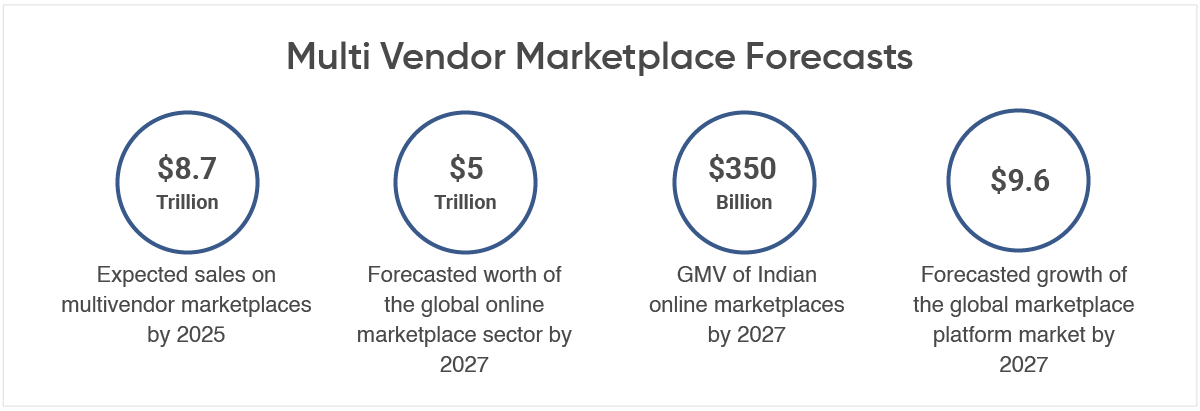
- $8.7 trillion is the expected sales on multivendor marketplaces by 2025
- $5 trillion is the forecasted worth of the global online marketplace sector by 2027
- $350 billion GMV of Indian online marketplaces by 2027
- $9.6 trillion is the forecasted growth of the global marketplace platform market by 2027
Source: Digital Commerce 360, Finextra, Bain & Co., Accel Partners, Statista, Pearl Organisation
Driven by rising customer demand, multi-vendor marketplaces are redefining ecommerce. But to build and manage a successful marketplace, you need a multivendor ecommerce platform designed for it, one that gives admins full control and keeps things simple for vendors.
After all, a multi-vendor marketplace thrives only when admins and sellers work seamlessly together. So here is a list of top 10 multi vendor marketplace platforms to consider for your online marketplace.
10 Best Multi Vendor Marketplace Platforms In 2026
In this article, we first present a detailed analysis of the must-have features in a marketplace software and then review the top 10 future-ready multi vendor marketplace platforms for enterprises.
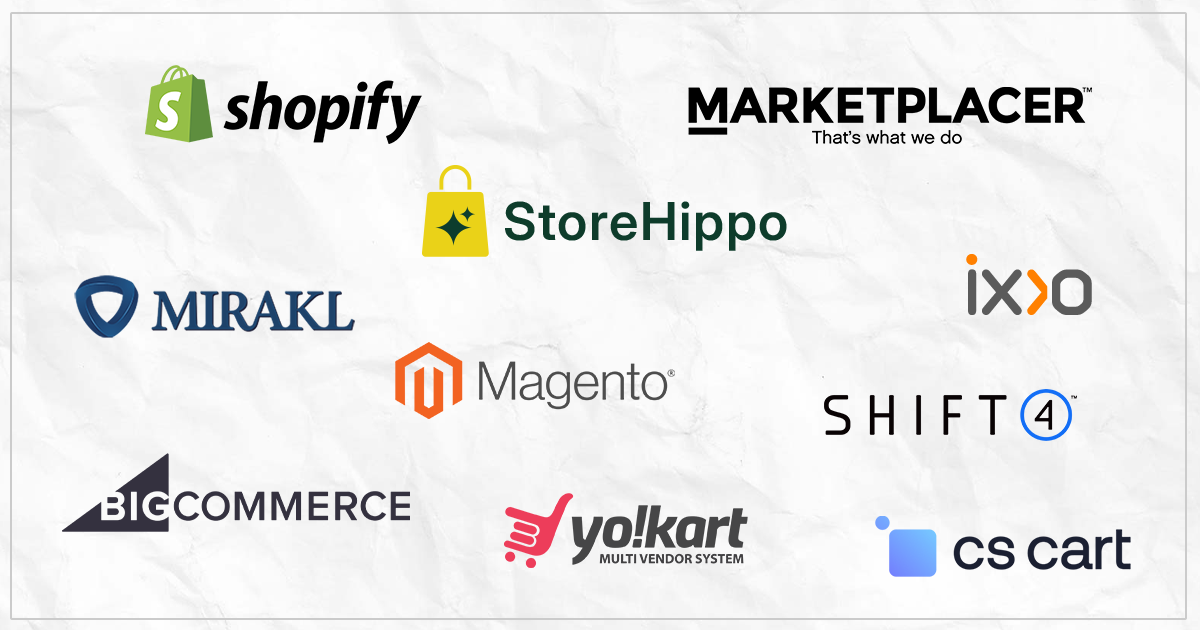
In this article, we present a detailed analysis of the must-have features in a marketplace script. Also, we would review the top multi vendor marketplace platform:
- StoreHippo
- BigCommerce
- Magento
- Shopify
- Shift4Shop
- Yo!Kart
- CS Cart
- Mirakl
- Marketplacer
- IXXO Multi-vendor
What is a Multi Vendor Marketplace Platform?
A Multi Vendor marketplace software is a special ecommerce application designed for building an online marketplace website where multiple vendors can come together to display and sell their products. On an online marketplace, sellers can have their unique seller sub-stores (micro-sites) or sell along with other sellers on the common marketplace website. Usually, multi-vendor solutions offer the provision of a separate vendor app where sellers can upload products, manage shipping, check payment status etc. and manage their complete business.

A well-rounded multi vendor marketplace software has a variety of modules and features like:
- The Admin app
- Separate Vendor App
- Customer or Marketplace App
- Hosting solutions (can be self-hosted or fully-hosted and managed)
- Inbuilt marketing features for business growth
- Seamless integrations with third-party software
How are Multi Vendor Ecommerce Platforms Different from Regular Ecommerce Solutions?
Multi vendor ecommerce solutions are special ecommerce software designed for the ecommerce set-up where multiple sellers sell on the same platform. The customers can buy different products from various sellers in the same cart.
Alternatively, regular ecommerce solutions are single-seller ecommerce software wherein the business owner is the seller and customers buy the products directly from the brand.
A multi vendor marketplace platform has a more detailed set of features needed to manage the complex set-up.
Must-Have Features of a Multi-Vendor Marketplace Software
Choosing the right marketplace eCommerce software can have a far-reaching impact on your business growth and success. To be able to make an informed decision you need to understand the must-have features and tools needed in your marketplace script. While it is important to consider the requirements of the admin and the vendors, it is equally important to check for the features needed for the end customers.
These features can take care of a variety of scenarios related to the admin-vendor-customer relationship. Also, in general, these features and modules should be easy to use for the vendors as well as the admin.
Here, presenting a detailed list of must-have features in a multi vendor eCommerce software:
Must-Have Multi Vendor Marketplace Software Features For The Administrators
A successful marketplace can be built only when the admin is in complete control. Hence, the need to have the right features and tools to run the show. Here is a list of marketplace features that equip the admin(s) of a multi-vendor ecommerce store to run the business seamlessly:
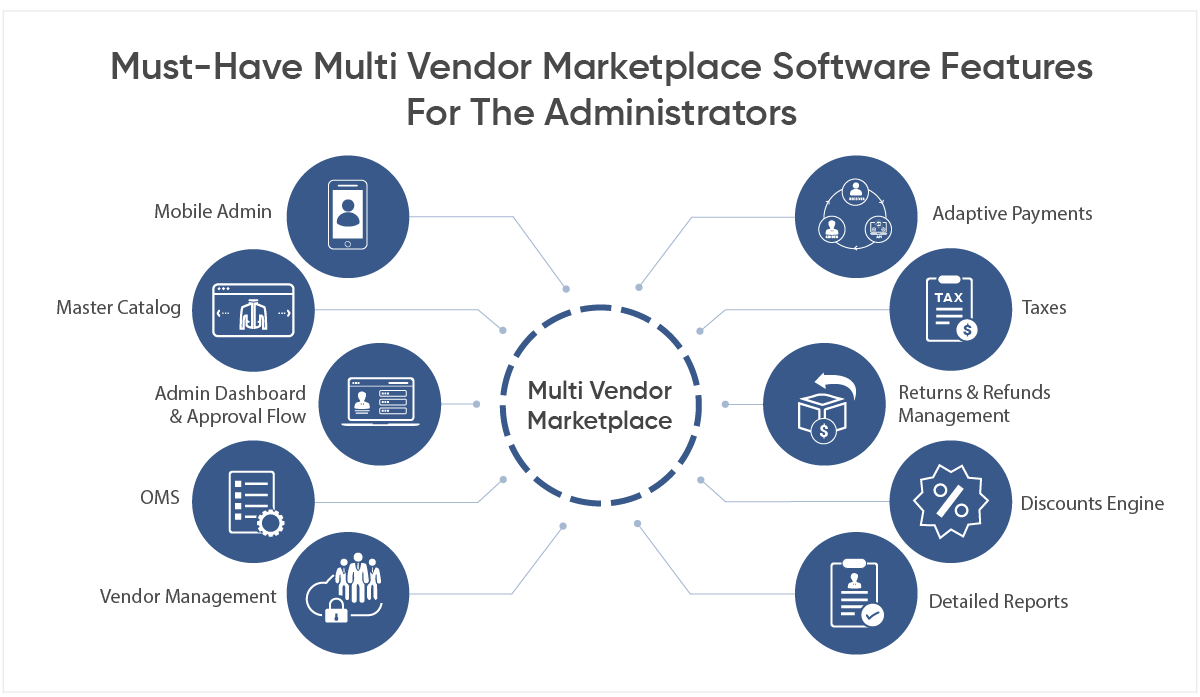
- Comprehensive Admin Dashboard: A one-stop solution with a host of features to manage the business, vendors and end-to-end business.
- Master Catalog: A centralised catalog that lists all the products in one master catalogue
- Mobile Admin: A mobile admin app that gives freedom to run the business on the go.
- Vendor Management: Complete control of all the vendor activities along with a detailed overview of vendor performance.
- Approval Flow: A flexible approval system where the admin can check and approve or reject all the products uploaded on the multi vendor marketplace by different sellers.
- OMS: Comprehensive order management system to manage the orders, inventory shipment etc for various vendors
- Discounts Engine: Ease of setting different vendor, product category or order level discounts with a powerful discount and marketing module.
- Taxes: Feature that enables the admin to easily set up multi-level taxes for different products, vendors or locations etc.
- Adaptive Payments: A solution/feature that helps the admin to distribute the payments of a multi-product order between different vendors.
- Returns and Refunds management: So the admin can easily manage the returns and refunds of products for different vendors
- Detailed Reports: To give a complete overview of the multi vendor marketplace platform’s performance, best selling vendors, products, geographies etc.
Must-Have Marketplace eCommerce Software Features for the Vendors
It is the vendors that help your marketplace scale up. Your vendors not only add new products to your multi-seller site but also help you reach new markets. Your marketplace solution should be well equipped to help your vendors, seller and distributors with easy registration as well as features to run their business smoothly.
Here is a list of features to look out for in your multi vendor marketplace platform:

- Quick and Easy Registration: The whole onboarding process should be easy and done within a few clicks. The vendors should be able to add all required documents and licences(where needed) easily and get quick approval.
- Separate Vendor Dashboard: There should be a separate vendor app on your online marketplace that gives the vendors the freedom to add products and manage their orders.
- Seller Based Sub-store: Unique microsites where sellers can display all of their products listed on your multi vendor marketplace.
- Store-Locations: This specifies the physical location of the sellers’ store. This feature helps in routing the orders to the nearest vendor and helps the vendors get more orders from their nearby areas.
- AI Tools: Built-in AI tools for cataloging and image enhancement to make it easy for sellers to make their their product listings faster, more accurate, and visually appealing.
- Comprehensive Product Management: To make it easy for the sellers to manage their products, inventory, orders etc.
- Seller Ledger: This module stores all the transactions of the sellers with all the entries of their credit and debit. This helps the vendors to have a transparent view of their commissions, payouts etc.
- Fulfilment Management: It is essential for the sellers on your multi vendor marketplace to have an automated shipping module to manage their shipments, choose their preferred shipping partners, pickups, returns etc.
- Reports and Analytics: Variety of reports to help the sellers get a sneak-peak into their best selling products, locations, orders, top customers etc.
Must-Have Multi Vendor Ecommerce Software Features for the Customers

While a multi-vendor ecommerce solution needs unique features for the administrator and the vendor, it should also offer features that make it easy for the customers to shop from the multi vendor marketplace.
To offer a memorable buying experience to your customers you need to offer features that engage, convert and retain them. Here are some of the must-have features to achieve this:
- Seamless Buying: Fast-loading mobile-ready marketplace site that works seamlessly even on slow mobile networks and entry-level devices.
- Easy Ordering Via Apps: Marketplace app so customers can order anytime, anywhere
- AI Powered Search and Recommendations : AI-powered search and recommendations for ease of finding exact matches quickly.
- Complete Product Details: 360-degree product view, detailed product information, FAQ etc. to make an informed decision
- Vendor Comparison: Allows customers to make an informed decision by comparing different vendors selling the same products.
- Features to make Informed Decision: Reviews and ratings to evaluate the product sold on the multi vendor marketplace based on the reviews of other buyers
- Easy Payment Options: Multiple digital payment options that are fast and secure along with COD
- Personalised Deals: Tailor-made discounts/offers along with loyalty wallets to receive loyalty points
- Multiple Shipping Choices: Variety of shipping options for paid or free shipping
Top Multi-Vendor Marketplace Software in 2026
Here is a detailed list of the top multi vendor solutions for brands of every scale and size. You can evaluate each of them individually based on their tech, flexibility and scalability along with the feature set provided by each.
1. StoreHippo Multi Vendor Marketplace Platform
StoreHippo multi vendor marketplace platform offers the most comprehensive native solution to build B2B, B2C, B2B2C and custom online multi vendor ecosystems and marketplace apps across industry verticals. You will find all the features listed above( for the admin, vendors and customers) in StoreHippo multi-vendor solutions.
StoreHippo also offers a host of other features that make it easy to run your online marketplace business. The composable, AI-native platform comes with powerful tools like semantic search, image-based cataloging, product recommendations, a voice- and text-based multilingual AI shopping assistant, and an AI image enhancer to automate routine tasks, improve buyer engagement, and deliver personalized shopping experiences at scale.
Built on headless architecture, StoreHippo lets you create innovative multi-vendor solutions and go omnichannel by adding any number of customer touchpoints using the same backend logic and API. StoreHippo comes with a rich themes library with multilingual support(including RTL languages) for static and dynamic content. You can easily customize your themes with inbuilt drag and drop tools.
- No plugins needed, quick set up, faster GTM of AI-native multi-seller websites, easy to use for all parties
- Fully customisable and scalable, suited for enterprises and white-labelled multi vendor marketplaces and custom marketplace ecosystems
- Simplified seller registration and onboarding with unique vendor dashboards and apps to enable vendors to manage products and orders independently
- Admin dashboard with full control, visibility, reporting, and analytics of entire marketplace operations
- Master catalog, which creates a central standard catalog with all products listed by all the vendors
- Flexible fixed or percentage-based commission management and automated vendor payouts with inbuilt vendor ledger
- Customisable shipping, payment, and discount options per vendor
- Split payments for multi-product orders across vendors
- SEO friendly marketplace software with inbuilt marketing tools, blog engine, and abandoned cart recovery
- 30+ Integrated logistics solutions with delivery boy module for seller-level agent assignment
- 60+ payment gateways with custom checkout flows
- Robust tax engine and invoicing support for multi-tier compliance
- Multi-store, multilingual, and multi-currency support for global expansion
- Hyperlocal ecommerce and Dealer Powered Quick Commerce solutions to dominate local markets
Pros
- 300+ inbuilt features for an end to end multi vendor marketplace solutions
- Mobile-first architecture to leverage m-commerce
- AI features that make cataloging, search and upselling easier
- Comprehensive multi-vendor solutions, no need for extensions, plugins or apps
- Pure headless architecture suited for large enterprises and advanced future-ready technology to build disruptive custom multi vendor marketplaces
- Fully integrated ecommerce platform that enables easy integrations for building innovative marketplaces
Cons
- Multi-seller feature is available only with the Enterprise and Platinum plans
- Tech teams transitioning from plugin-based platforms may initially feel the absence of plugins, until they discover the full suite of built-in features
- Global market presence is still expanding compared to older plugin-based multi vendor platforms
Price
Enterprise Plan- $499+/month
Platinum Plan - $1999 on a minimum one year term
2. BigCommerce Multi-Vendor Solution
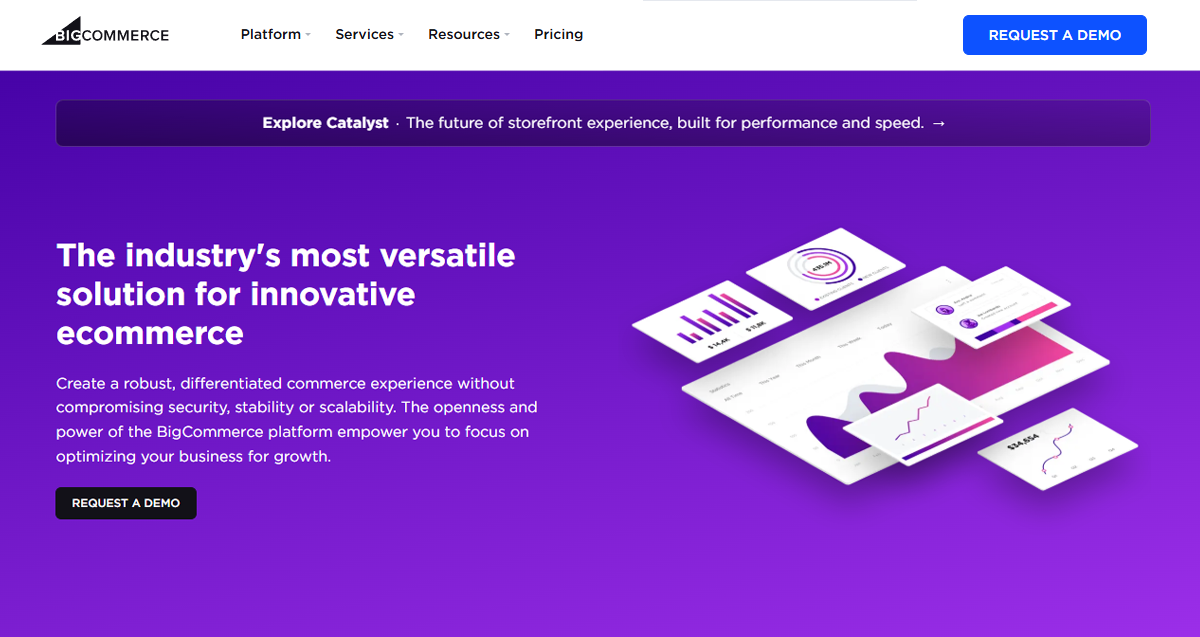
BigCommerce does not offer a native multi-vendor marketplace setup out-of-the-box, but you can extend a regular store into a multi vendor marketplace website using apps like Webkul Multi Vendor Marketplace or through its Marketplacer connector. These apps enable vendor onboarding, product approvals, commission settings, and independent vendor dashboards, giving admins full control while allowing vendors to manage their own catalogs and orders.
BigCommerce marketplace eCommerce software gives you a host of features to manage your vendors and run the online marketplace. The admin dashboard is feature-rich with the option to auto-approve the vendors. The admin has a clear view of vendor activities and no vendor can sell any products without the admin’s approval.
With the BigCommerce multi vendor marketplace software you can easily set up different levels of commissions for your vendors based on orders, percentage or subscription. You can also manage vendor payments easily with a streamlined payment management system.
BigCommerce has recently integrated AI-powered tools for enhanced search, predictive analytics etc, but they are not for all users.
Check out the pros and cons of the BigCommerce marketplace plugin before considering it for building your multi vendor website.
Pros:
- Easily convert an existing BigCommerce store into a multi vendor marketplace
- Strong app ecosystem (Webkul, Marketplacer) with varied features
- Native AI tools for product recommendations, search, and analytics
- Global-ready with multi-currency, multi-language, and multi-storefront support
Cons:
- Multi-vendor features are not native, require third-party apps/extensions
- Costs add up: store subscription + marketplace app + add-ons
- Limited vendor storefront design options without developer input
- AI features still rolling out and not fully available for all users
Pricing:
- $105/month (Plus)
- $399/month (Pro)
- Enterprise plans available on request
- Marketplace apps like Webkul start from $10/month, with additional charges for advanced features
- Limit on annual sales for each plan which forces to move to higher plans as the business grows
3. Magento Marketplace Extension
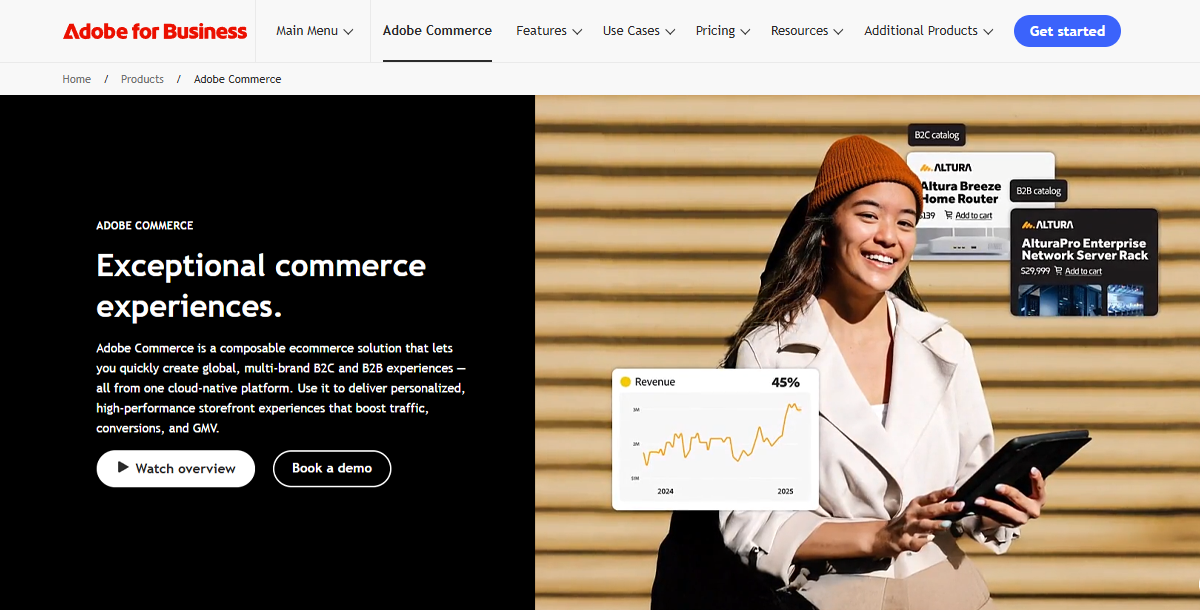
Magento (Adobe Commerce) does not provide a native multi vendor marketplace setup. To transform a Magento store into a marketplace, enterprises need third-party marketplace extensions such as CedCommerce Multi-Vendor, Webkul Multi Vendor Marketplace, or similar solutions. These extensions enable vendor onboarding, commission management, product approval workflows, vendor dashboards, and order management features, giving admins central control over marketplace operations.
Magento’s open-source and Adobe Commerce versions both allow customisation and flexibility, to build highly tailored multi-vendor setups. The platform also supports advanced catalog management, multi-storefront, multilingual and multi-currency features, for building global multi vendor marketplace platform. Magento can integrate with ERP, CRM, and logistics providers, though technical expertise and familiarity with the Magento platform is often required.
Pros:
- Free software to start an online store with a paid plugin for multi vendor marketplace
- Highly customizable open-source architecture with a wide range of third-party extensions
- Strong support for multi-language, multi-currency, and multi-store setups
- Seasoned developers can create custom marketplaces
Cons:
- Needs proficient developers who have prior experience of handling the platform
- Steeper learning curve with significant technical/development needs
- Add-ons and custom development increase overall TCO (Total Cost of Ownership)
- Prone to security issues and buggy code
- Ongoing maintenance and hosting can be expensive. Frequent upgrades force migration to new versions
Pricing:
- Free for Magento Open Source but requires hosting, extensions, and developer resources.
- $22,000/year starting price for Adobe Commerce (enterprise version) and further custom pricing depending on scale and GMV.
- Marketplace extensions like CedCommerce or Webkul come with additional licensing costs, usually starting from a few hundred dollars.
4. Shopify Multi-Vendor Plugin
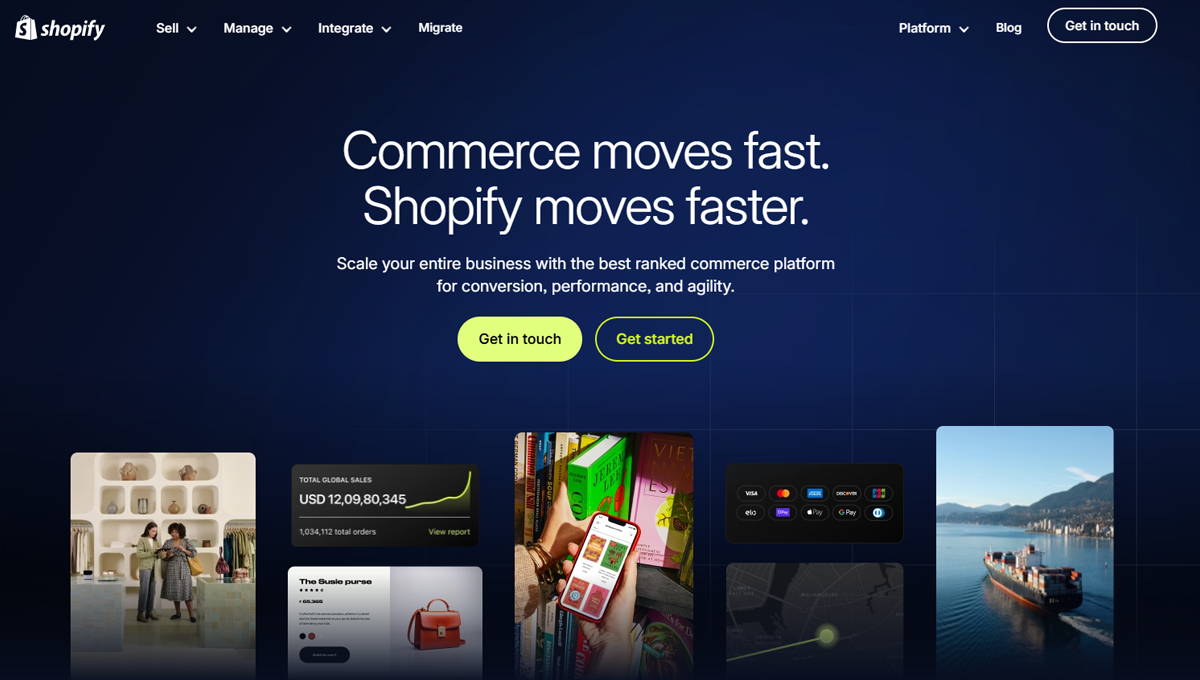
Shopify is a well-known ecommerce platform that supports different ecommerce models along with multi vendor marketplace. However, Shopify does not offer a native marketplace software. With Shopify, you will need the Webkul multi-vendor plugin to extend a regular Shopify store into a marketplace website. You can use other third-party plugins to get end-to-end marketplace features for your online marketplace.
Shopify marketplace plugin gives a host of features and tools for the administrators, which give them complete control over the marketplace. Admin can send invoices, reminders for order fulfilment etc. Sellers can have their profile page and customers can rate the sellers based on their experience.
Shopify plugin for multi vendor marketplace software allows you to set up different commission structures for the vendors. Shopify also offers different paid and free design themes to create an engaging marketplace website. However, along with the Webkul marketplace plugin, you would need additional apps to have a fully-functional multi vendor marketplace.
While Shopify provides a reliable SaaS foundation with easy setup, mobile-friendly themes, and strong payment integrations, its multi-vendor functionality heavily depends on apps. This means additional costs and complexity, as different apps may be required for shipping, payouts, and advanced vendor workflows.
Pros:
- Simple, fast setup with SaaS convenience
- Large ecosystem of third-party marketplace apps
- Variety of free and paid themes to design your marketplace
- Easy integration with shipping, POS, and marketing tools
Cons:
- No native marketplace features; requires multiple third-party apps to build an enterprise multi vendor marketplace software
- Costs can rise quickly with app subscriptions and add-ons
- Limited flexibility compared to open-source platforms
- Requires developer expertise in Liquid for deeper customizations
Pricing:
- $399/month For Shopify(Advanced)+ $10–$45/month for Marketplace Plugin costs + more paid plugins for advanced features
- $2,000/month for Shopify Plus (enterprise) + $10–$45/month for Marketplace apps like Webkul, with higher fees for advanced feature
5. Shift4Shop (Earlier 3dcart) Marketplace

Shift4Shop, which was 3Dcart earlier offers a multi vendor marketplace software to small or large multi vendor websites easily. With its acquisition by Shift4 group it now comes with the added advantage of having its own secure payment processing.
3dcart or Shift4Shop has a feature-rich and intuitive admin dashboard that allows the admin to have complete control of the business, run and grow it in an organised manner. You also get a variety of free and premium design templates to give a different look to your multi vendor marketplace website based on your specific industry.
Shift4Shop multi-vendor solutions also has advanced tools for reporting and inventory tracking which come in handy when running an online marketplace with a vast range of products from different vendors. The SEO-friendly platform can be easily integrated with third-party providers and comes with inbuilt tools for shipping and accounting.
Pros:
- Free domain name with paid plans
- Integrated payment processor. No set up charge if using their payment processor
- Host of inbuilt ecommerce and reporting tools
- Scales for both small and large marketplace setups
Cons:
- Steep learning curve
- Users complain that despite a host of inbuilt features they need quite a few add-ons which add to the overall cost
- Limited design tools for non-technical users and bland templates do not help with new-age marketplace website design
- Even after switching to a new platform in 2020, most of the knowledge base questions and answers are for the old platform which makes it difficult to find the right solutions
Pricing:
- $299/month for Standard plans
- $2,000+/month for Enterprise plans
- Marketplace features requiring additional apps/extensions
- Enterprise-grade marketplace setups are custom priced
6. Yo!Kart Multi-Vendor
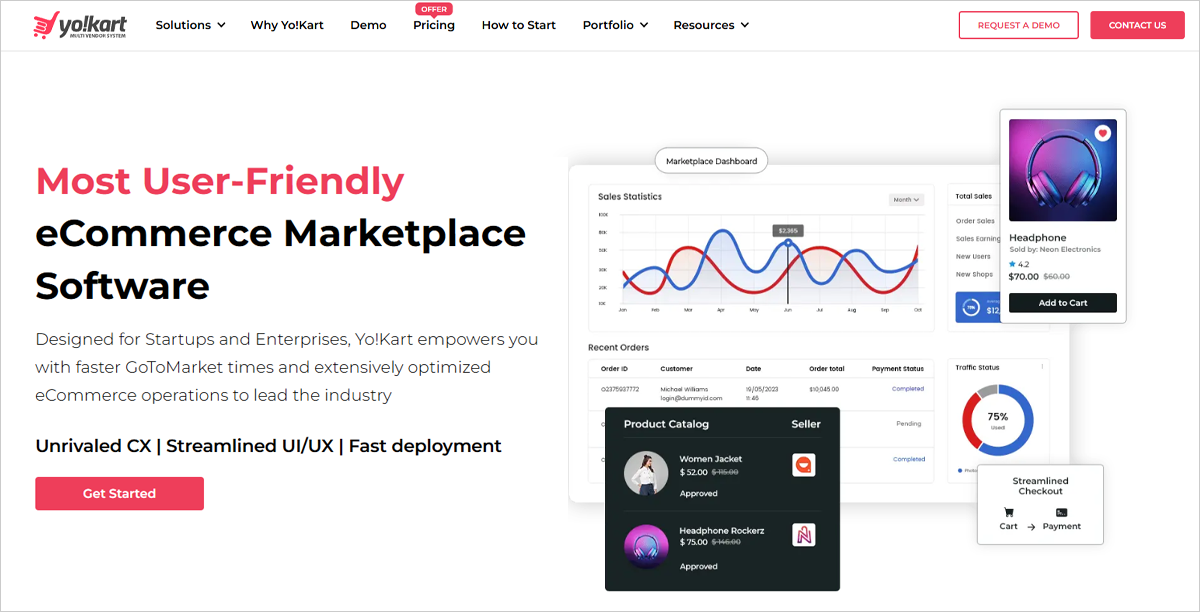
Yo!Kart multi-vendor solutions is a relatively new yet popular marketplace software with native solutions for multi-seller model. It offers an SEO-friendly platform for small and large businesses along with a feature-rich admin panel, 15+ integrated payment gateways, great user interface and social media integration. All of these put together makes it a good option for creating a multi-seller shop for any business.
Yo!Kart also has mobile apps for vendors, along with a marketplace app. Its inbuilt CMS and host of SEO tools make it easy to publish optimized blogs for your multi vendor marketplace website. Yo!Kart’s responsive and user-centric design features make it easy to build engaging marketplace store layouts.
Pros:
- Great storefront design
- Easy to use and manage
- SEO-friendly architecture and host of SEO tools
- Marketplace apps availability and scalable for small to medium businesses
Cons:
- Difficult to customise, slightest changes need coding expertise and considerable time
- Users complain that Yo!Kart multivendor marketplace software’s one-year free tech-support is basically of not much use as you cannot make changes to the complex code without having an expert developer in your team
- Product upgrade policy is unclear
- Ensuring security for enterprise businesses is costly
Pricing:
- $999 one time starting
- $1,249 - GoQuick one time
- $2499- GoQuick Boost
- $6,249- GoCustom
- Additional cost for the following- tech support after free period+mobile apps+upgrades
7. CS Cart Multi-Vendor Software
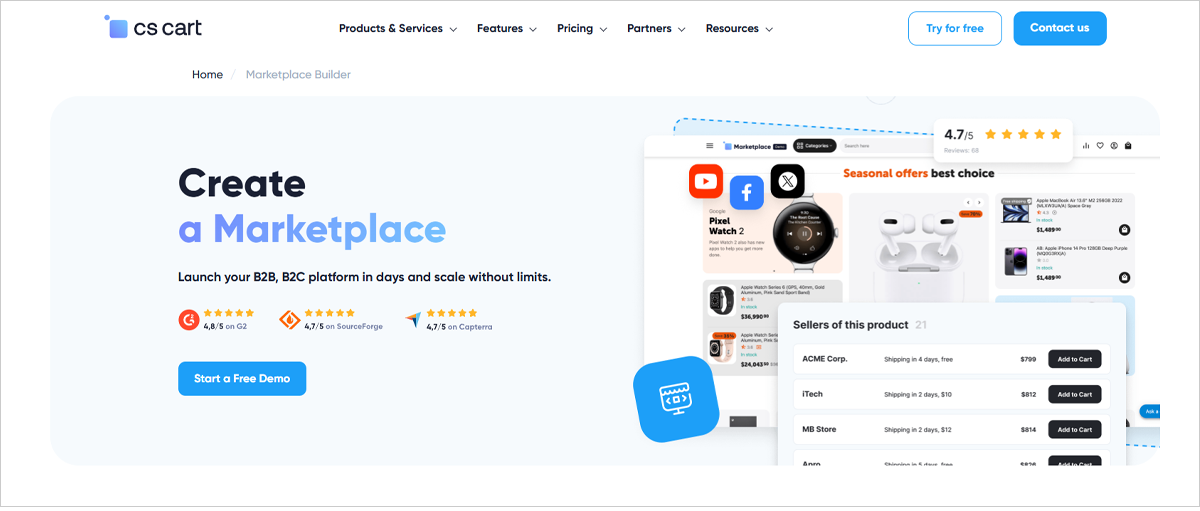
CS-Cart is a popular self-hosted ecommerce platform that comes with native multi vendor marketplace capabilities. It offers on-premise and cloud marketplace solutions. It enables businesses to launch full-featured online marketplaces with vendor registration, dedicated dashboards, product management, and order tracking. Admins can control vendor approvals, set commission structures, and monitor performance, while vendors manage their own storefronts, catalogs, and promotions.
The multivendor marketplace platform includes built-in SEO tools, responsive themes, and a robust add-on marketplace for extending functionality. CS-Cart also offers a “Multi-Vendor Plus” and “Multi-Vendor Ultimate” edition with advanced features like vendor mobile apps, common product catalog, and separate vendor storefronts. While feature-rich, CS-Cart requires hosting and ongoing technical management, making it better suited for businesses with inhouse developers.
Pros:
- Native multi-vendor functionality without relying on third-party apps
- Dedicated vendor dashboards and mobile apps (in higher editions)
- Rich feature set with strong admin control and analytics
- Large marketplace of add-ons and extensions for customization
Cons:
- Requires self-hosting and technical expertise for setup/maintenance of the marketplace software
- Can get expensive with add-ons, upgrades, and scaling
- Default themes are functional but not highly modern out-of-the-box
- Upgrades and ongoing support come at additional costs
Pricing:
- Different pricing plans for on premise and cloud multi vendor marketplace solutions
- $155/month for Pro with revenue limit of $10,000
- $295 for Advanced with unlimited revenue
- Ongoing hosting, add-ons, and support incur extra costs
8. Mirakl Multi-Vendor Marketplace

Mirakl is an enterprise-focused multi vendor marketplace platform used by several large businesses across the globe. Built for scalability, it helps enterprises, retailers, and B2B brands set up and manage online marketplaces with features for vendor management, product approvals, and compliance controls.
The platform also offers advanced catalog tools, AI-based product matching, and automation to simplify vendor onboarding and operations. With its wide adoption in industries like retail, manufacturing, and distribution, Mirakl multi vendor software has earned some big global clients looking to expand with the marketplace model.
Pros:
- Enterprise-grade solution trusted by global brands
- Advanced AI and automation tools for product and vendor management
- Scalable architecture to support large catalogs and high traffic on enterprise multivendor marketplaces
- Strong ecosystem of integrations and partner network
Cons:
- High cost of ownership makes it less feasible for SMEs
- Implementation requires significant technical expertise and time
- Customisation often needs dedicated development resources
- Best suited for large enterprises with inhouse tech team
Pricing:
On request (enterprise-focused pricing model)
9. Marketplacer Multi-Vendor Marketplace
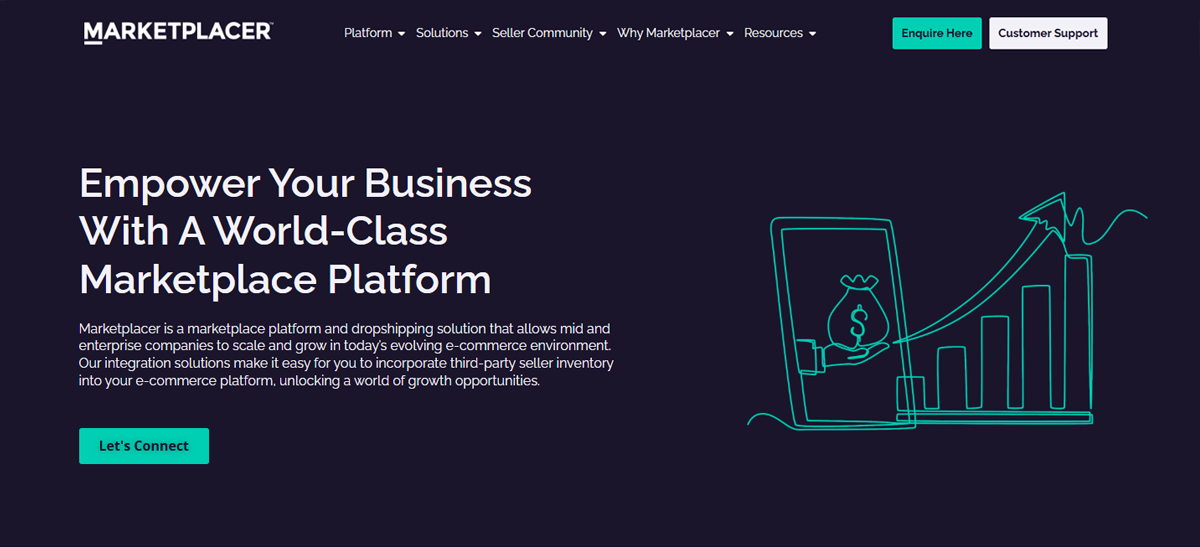
Marketplacer is a SaaS-based multi vendor marketplace platform for businesses of all sizes. Businesses using Marketplacer canlaunch and scale online marketplaces quickly. Marketplacer is used by retailers, distributors, and communities across the globe to connect sellers and buyers under a unified ecosystem. Its cloud-native setup makes it flexible for both B2C and B2B use cases.
The multivendor marketplace platform comes with features like vendor onboarding, commission management, catalog and order management, and integrations with leading payment and shipping providers. Marketplacer also supports affiliate and dropshipping models, allowing enterprises to expand product offerings without managing physical inventory. Its modular design helps brands scale steadily while maintaining control over operations and user experience.
Pros:
- Cloud-native, SaaS-based solution that is easy to scale
- Supports affiliate and dropshipping models alongside marketplace setups
- Flexible enough for both B2C and B2B businesses
- Strong focus on vendor onboarding and catalog management
Cons:
- Pricing can be high compared to smaller marketplace builders
- Limited out-of-the-box design flexibility; customization may need technical support
- Some advanced features for multi vendor marketplace functioning require third-party integrations
- Best suited for medium to large businesses rather than very small startups
Pricing: On request (SaaS subscription-based model)
10. IXXO Multi-Vendor Marketplace
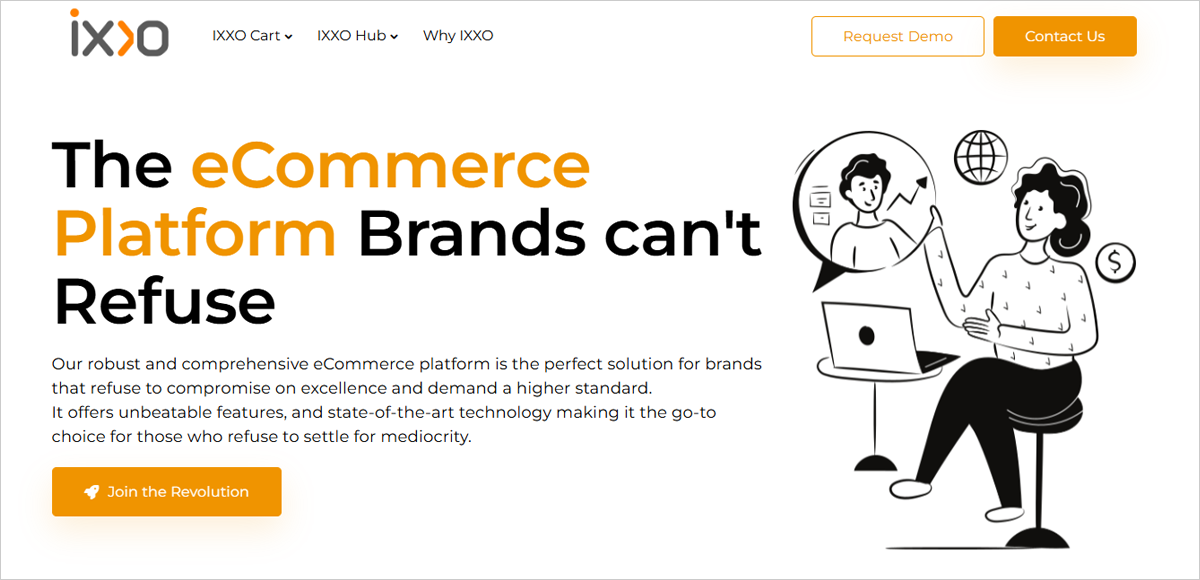
IXXO Multi-Vendor is an open-source multi vendor marketplace platform built specifically for creating multi-seller marketplaces. With flexible deployment options (self-hosted or cloud-based) it can be used by businesses of varying sizes right from startups to established enterprises. Its modular architecture allows admins to manage vendors, commissions, products, and orders seamlessly while giving vendors their own dashboards to handle listings and sales.
The multivendor marketplace platform offers strong customization options, multi-language and multi-currency support, and integrations with popular payment and shipping providers. IXXO is often chosen by businesses that want full control over their marketplace setup along with the ability to extend functionality through custom development.
Pros:
- Open-source solution offering full ownership and flexibility to build multi vendor marketplaces
- Supports both cloud and self-hosted deployment models
- Multi-language and multi-currency support for global reach
- Highly customisable with modular architecture
Cons:
- Requires technical expertise for setup and ongoing maintenance of the marketplace website
- Limited design templates compared to SaaS competitors
- Support and updates depend on licensing and developer involvement
- Custom development can increase time and costs
Pricing: Varies by license and hosting option (one-time and subscription models available)
How to Choose the Right Multi Vendor Marketplace Platform for Your Business
Building your marketplace website is one of the most crucial decisions you make for your business. While there are a host of marketplace builders available in the market, choosing the best fit solution for your business needs careful consideration and analysis of the available options. You need to evaluate the performance of the available multi vendor marketplace platforms based on the technology, features, ease of use and flexibility for customizations.
In this article, we have evaluated the 10 best marketplace software. These marketplace solutions can support businesses of different models and industry verticals. However, before you make your final decision, do evaluate the respective multi-vendor solution by connecting with their team for a demo.
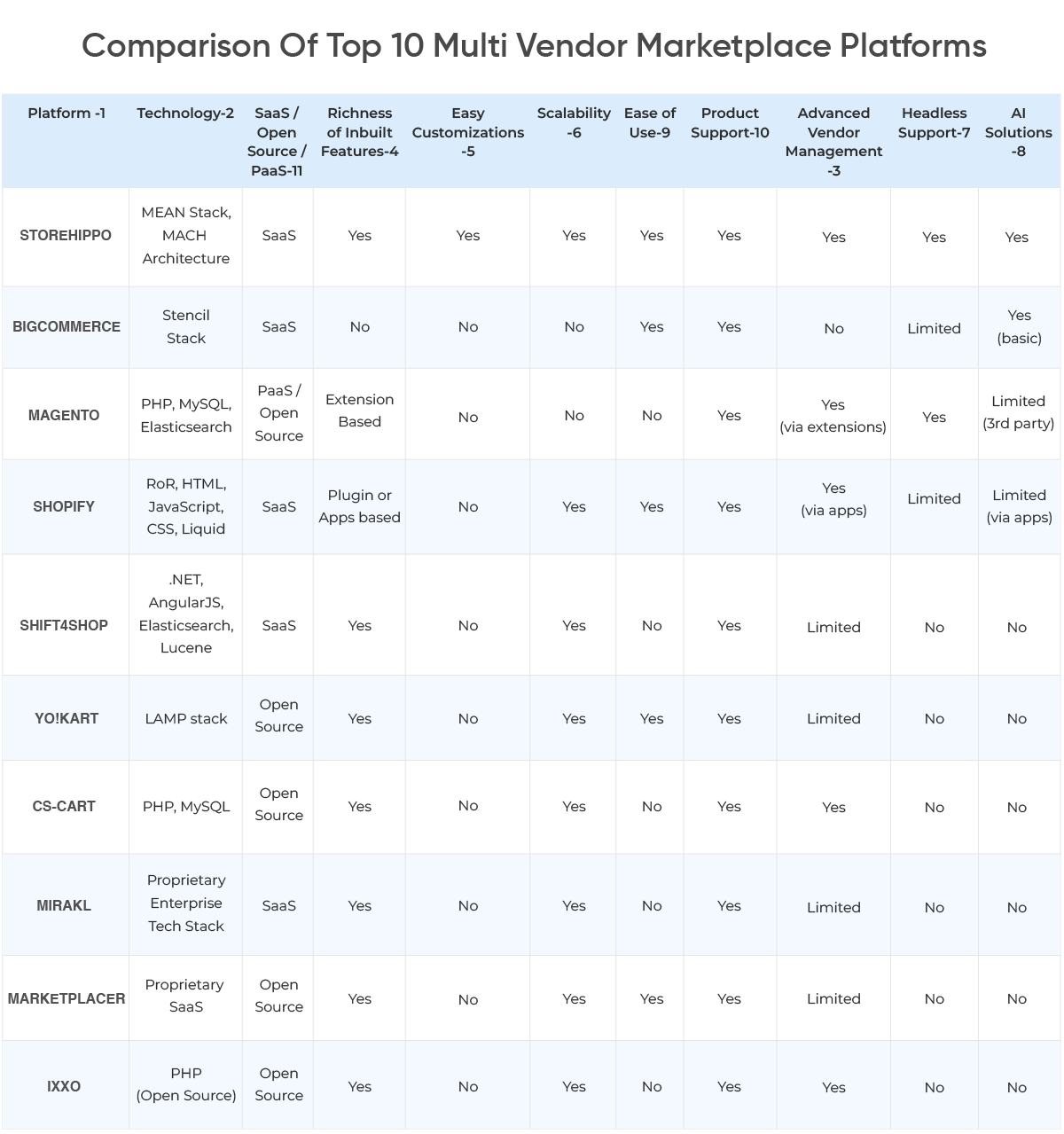
So get started with evaluating the top multi-vendor solutions. Begin from the very first in the list, book your StoreHippo personalised demo right away!
How to Build a Marketplace Website?
Getting started with your own online marketplace is a smart business move. However, how to build an online marketplace website is a question that bothers many. Usually one has two broad choices;
- Create an online marketplace right from scratch by hiring a team of developers
- Build your multi-seller website with a turnkey multi vendor marketplace platform
You can go with either of the options, but the first one requires a lot of investment in terms of time, money and other resources. You will have to set up a team of developers and testers to go through iterative cycles of coding, deployment, testing etc. Are you ready to wait for months or even years to go to market with your multi vendor portal?
Certainly not!
So, the second option is the pragmatic choice, given that there are a variety of turnkey marketplace builders in the market. In the sections above, we have already reviewed the best multi vendor marketplace platforms. These marketplace website builders offer a comprehensive solution to build, launch and market your own multi vendor website.
You just need to choose your preferred multi vendor marketplace platform and get started in few easy steps:
Step 1: Decide on your marketplace eCommerce software and buy a domain name. If it is SaaS-based you need to just buy the subscription and not worry about hosting. With on-premise multi vendor software, you will need to buy the hosting as well.
Step 2: Build your marketplace website.
Step 3: Onboard sellers and ask them to upload their products.
Step 4: Set up payment, logistics and customer support.
Step 5: Market and launch your multi vendor website.
How to Promote your Multi Vendor Marketplace Business?
Just onboarding vendors and listing products is not enough to make your business successful. You need to take measures to promote your online marketplace brand to attract more buyers.
Here is how you should go about it:
- Set up a “launching soon page” and register buyers before your actual launch
- Give buyers promotional offers or store credits to encourage them to buy from your multivendor website
- Ask your registered customers to bring in more buyers by offering them reward points for referrals
- Offer value-added services like free shipping or free products to attract more customers to your marketplace website
- Attract vendors to your multi vendor marketplace by using your subscriber list as proof of customer interest in your marketplace brand
- Set up terms and conditions that favour your vendors’ business growth, having more sellers will help you add diverse catalogues
- Engage customers through social media platforms and create a buzz about your brand
With these strategies in place, you can easily promote your marketplace website and start seeing a good flow of customers to your business.
Why Multi Vendor Marketplace is the Best-Fit Model for Your Enterprise Business?
Enterprise businesses are characterized by large volume sales, high scalability and diverse product range. Also, enterprise businesses consist of a huge network of dealers, sellers, distributors and other partners that keep the wheels of the business moving. Running such a mammoth set up becomes much easier when brands opt for enterprise marketplace solutions to streamline and automate their processes.
A report by Gartner suggests that brands that have been operating their enterprise marketplaces for at least a year can see at least 10% growth in net digital revenue. An online marketplace solution makes it easy for the admins and other partners of an enterprise brand to run the show seamlessly easily.
Here is why more and more enterprise brands are shifting towards some form of marketplace solutions to manage and grow their business:
- The marketplace setup makes it easy for large brands to scale up to new product lines or geolocations by onboarding new vendor partners
- Enables brands to implement advanced strategies like differential pricing, login based catalogues and prices, location-based services like payment gateways or shipping solutions etc.
- Managing various networks of sellers, dealers, affiliates, delivery partners etc. becomes streamlined and efficient using an advanced multivendor software
- Help in building better brand presence and value by offering products and services of different brands under one enterprise brand’s umbrella
- Enables brands to go for targetted marketing approach by creating multiple customized stores catering to different audiences
- The multi vendor marketplace model can be easily combined with some other business models like multi store, multilingual, hyperlocal commerce etc. to build a disruptive solution that unleashes an enterprise brand’s growth potential
However, to gain maximum benefit from building your enterprise multi vendor marketplace, your brand needs a future-ready marketplace builder that quickly adapts to dynamic market requirements and customer demands.
Why Multistore Marketplace Website Model is Good for Taking Your Enterprise Business to International Markets?
While the multi vendor model is already a huge hit, enterprise price brands are now leveraging hybrid commerce by building multistore marketplaces to expand their business beyond borders.
A multistore multivendor marketplace is a marketplace website which has a network of sub stores based on location. These sub-stores are personalised to target a specific audience segment and offer custom catalogs, deals, delivery and payment solutions to customers based on their geo-location.
10 Benefits of Building Multi Store Enterprise Marketplace Website
Enterprise brands can reap the following benefits by building their multistore marketplace for international markets:
1. Global Reach- Reach international buyers by offering them tailored sub-stores for their unique requirements and localised for their ease of use.
2. Build Brand Presence Quickly- By onboarding local vendors from different countries marketplace websites can quickly create a vast catalog and gain nuanced insights about new markets based on their vendors’ feedback and business acumen.
3. Diverse Product Offerings- With a variety of sellers on the multi vendor marketplace platform enterprises can offer showcase a diverse range of products, catering to a wide international audience.
4. Leverage Localization- By personalising each marketplace sub-store for local audiences and offering local language, products, shipping and payment options marketplace brands build a better connection with their audience. This in turn results in better engagement and conversions.
5. Reduced Operational Costs- By building sub-stores for vendors from a given location and offering them the tech infrastructure, enterprises can leverage the vendors’ physical infrastructure, warehouse etc., to save costs and introduce multi-level efficiencies.
6. Boost Sales- With a network of multiple sub-stores for your marketplace spread across geographies, you are bound to get better traffic and sales which eventually lead to higher profits and sustainability.
7. Improved Targeting- By offering region-specific products and services on their multi-store multivendor marketplace website enterprises can target local buyers better across diverse international markets.
8. Competitive Advantage- A multi-store marketplace carves a niche for your brand by making your brand stand out as an enterprise with a multi-geography presence and a customer-centric approach by offering localisation.
9. Risk Mitigation- With your marketplace sub-stores in multiple locations, your risks related to market-specific volatility are diversified and cushioned off with a multi-location presence.
10. Access to Rich Customer Data- Having a multi-store multi vendor marketplace means you have access to a wide range of data on customer behaviour, preferences, buying patterns and more. This can help you build strategic plans to accelerate growth.
While a multi store marketplace website is a lucrative business idea, to build one and run it successfully requires an advanced multi vendor marketplace platform that comes with both multistore and multi seller features. To build your multi-store enterprise marketplace for global markets choose one of the best multivendor eCommerce software by thoroughly exploring its multi store and multi seller capabilities.
Choosing The Best-Fit Multi Vendor Marketplace Platform For Your Business
The multi-seller ecommerce model is undoubtedly the winning formula that can keep you ahead in the ecommerce race. However, to make the most of the current ecommerce boom you need to go with the ideal marketplace builder. While all of the listed platforms have ample features to build and manage your business, you will have to evaluate each of them according to your requirements, budget, business model, customizations and ease of use.
Hope this article helps you make an informed choice regarding the best suited multi vendor marketplace platform for your business. Before you make the final decision, do evaluate each of these platforms by getting a thorough understanding of their features, prices and customizations available. So get started right away with the first in the list.
Book your demo with StoreHippo now!
FAQ
1. What is a multi vendor marketplace?
A multi vendor ecommerce store is an online portal where multiple sellers showcase and sell their products or services to the customers.
2. How does an online marketplace function?
Usually, the multi vendor website works on the commission model. The administrators or owners of the marketplace get the IT infrastructure up and running. Then they invite different sellers to sell on their online marketplace website. The sellers sell their products and pay a certain percentage or fixed amount to the marketplace owner as revenue.
3. What are the different types of online marketplaces business models?
There could be many different use cases of a multi vendor marketplace based on their business model.
Following are the different types of online marketplace models:
- B2B Marketplace that sells goods and services to other businesses. Examples: IndiaMART, Alibaba, etc.
- B2C Marketplace offers goods or services for sale directly to the end customers. Examples: Amazon, Flipkart etc.
- P2P Marketplace brings together people who want to sell or buy products or services on a single platform. For example Etsy, OLX etc.
- B2B2C Multi Vendor Marketplace: This type of marketplaces are also called three sided marketplaces as it brings together different businesses on a single platform and then connects them to the end customers. For example, food aggregators like Swiggy, Zomato etc.
4. What are the different types of marketplace websites based on the types of products or services they offer?
Following are the different types of online marketplaces categories based on the products and services sold on them:
- Horizontal Marketplaces that sell a vast variety of products like Amazon, Flipkart, Alibaba etc.
- Niche or Vertical Marketplace that sell a niche line of products cosmetics, baby products etc. For example FirstCry, Nykaa.
- Service Aggregator Marketplace that aggregates the services of multiple providers on a single marketplace website. For example, food delivery service aggregator Zomato, or multiple services aggregator platform Urban Company.
- Rental Multi Vendor Marketplace that offers a product or service on rent like Uber, Rentomojo etc.
- Hybrid Marketplace Websites where different products(Alexa from Amazon) and services(like Amazon Prime streaming service) are offered by an online marketplace brand
- Hyperlocal Marketplace that specializes in offering products and services quickly within a specific location like a city, a neighbourhood etc. Examples of such online marketplace platforms are Yelp, Urban Company etc.
- Custom Marketplaces that combine a variety of business models along with the multi-vendor set up to create disruptive and innovative multi vendor marketplaces
5. What are the different revenue sources of an online marketplace?
The primary revenue source of a multi vendor marketplace is the commission earned on the orders sold on the multi vendor marketplace platform. They can also create alternative revenue sources by;
- Creating their own range of products to be sold on the marketplace
- Offering paid membership for premium services like fast delivery, access to additional discounts etc.
- Charge registration fees from vendors selling on their platform
- Offer paid advertising spots on the marketplace website
- Earn from the prime-spot listing for products or vendors on their online marketplace
- Affiliate and referral programs that boost customer reach
6. How to make a marketplace website successful?
To make a multi vendor marketplace business successful, one needs to do the following:
- Well-thought and planned business and marketing strategy
- Constant upgrades/changes to adapt to market dynamics
- Vision to scale the business to new markets and products
- A well rounded multivendor eCommerce software to power the business
7. How do I start a marketplace business?
To launch a multivendor business, build a business plan as follows:
- Do a detailed market research
- Identifying the demand gap
- Choose the product(s) or services you want to offer
- Opt for the best-fit business model
- Planning for seamless operations
- Quickly build your multi vendor marketplace website
- Start onboarding vendors
- Start promoting your business on various online and offline channels
- Test your marketplace website’s end to end operations with mock orders
- Make changes in supply chain and other operational plans if needed
- Build your marketing strategy to get more organic and paid traffic to your marketplace website
8. What is the cost of building a multi vendor marketplace in 2026?
The cost of building a multi vendor marketplace in 2026 depends on your business goals, feature complexity, and the ecommerce platform you choose. Developing a custom marketplace from scratch can cost anywhere between $35,000 to $2,00,000 or more, considering design, development, hosting, maintenance, and scalability requirements.
In contrast, opting for a SaaS-based enterprise ecommerce platform like StoreHippo significantly reduces both upfront and long-term costs. You can get a fully hosted, ready-to-launch multi vendor marketplace with built-in features such as vendor management, AI-powered search, integrated logistics, and multi-store support starting at less than $500/month.
9. How much is the cost of building a marketplace app?
You need not spend extra time or money in building a marketplace app if you choose a multi vendor marketplace platform that comes with an inbuilt app builder. For example, with StoreHippo multi vendor solution you can build Android and iOS marketplace apps directly from your admin panel. You can also get apps for your admin panel, separate apps for your vendors and delivery boys with StoreHippo multi-vendor solutions.
10. How long does it take to launch a marketplace?
With cutting-edge turnkey marketplace eCommerce software, you can launch your online marketplace in 7-10 days.
11. Is it possible to make tailored enterprise marketplace using turnkey multi vendor software?
Yes, with advanced multi-vendor solutions built on headless architecture, it is easy to tweak the frontend and backend separately to create tailored solutions for unique brand needs. With their creative freedom, agility and seamless integrations using APIs, headless marketplace platforms make it easy for enterprise brands to build customized solutions that fit their brand’s requirements.
12. Why building a multilingual online marketplace is a good idea?
Building a multilingual marketplace website is a good way to differentiate your enterprise brand from competitors. Research suggests that 68% of customers like to interact with brands in their native language. Also, 64% customers are ready to pay more for products or services that are offered in their native language.
Considering the changing buyer expectations and demand for hyper personalization, it is a good business move to build an enterprise marketplace in multiple languages. StoreHippo comes with built-in multilingual support wherein brands can convert their multivendor store into 100+ languages including RTL languages.
13. How to implement vendor-based taxation on an online marketplace?
Advanced multi-vendor solutions like StoreHippo come with built in tax-engine that takes care of vendor based taxes. StoreHippo has full support for GST, CGST, SGST and IGST. Different taxes can be added for domestic and international vendors on the marketplace using the tax-based rule feature.
Also, there are multiple editable, built-in GST compliant invoices which make accounting and tax compliance easier for marketplace brands.
14. How soon can I start making money on my online marketplace?
With the right vendor onboarding and commission policies, you can start making money on your marketplace as soon as you launch it. You can take one-time onboarding fees from your vendors, get paid for product placements and subsequently earn commissions on each item sold on your multi vendor marketplace website. You can also start earning money by offering premium membership to your customers. With the right marketing strategy in place, you can get decent footfalls and orders on your online marketplace right from the day of launch.
15. How do I find vendors for my marketplace website?
You can get vendors for your online marketplace in the following 5 ways:
- Check sellers on popular marketplaces and contact them with your proposal
- Go to sites like IndiaMART and contact the vendors related to your business
- Connect with relevant vendors offline, through your contacts build during market research, personally contact sellers and distributors, get connected through business clubs etc.
- Connect with marketplace vendors on social media platforms, networking groups, trade associations etc.
- Ask onboarded vendor partners to refer other vendors for your multi vendor marketplace website
16. How do I plan an onboarding strategy for the vendors on my online marketplace?
To onboard the best vendors you need a well-thought vendor onboarding strategy in place. Follow the following steps to prepare your onboarding process:
- Research your vendors to gather their business details, any legal paperwork etc.
- Issue a Request for Proposal (RFP) so that both parties are clear about the rules, processes and policies before starting the business.
- Compare and evaluate vendors based on their prices, business volume, location, order taking and fulfilling capacity etc.
- Do a vendor risk assessment to ensure that you are onboarding reliable and good vendors on your online marketplace website.
- Check vendor credentials by going through their digital presence on popular trade and networking groups or through word of mouth referrals.
- Plan an exit strategy with detailed service requirements and termination of the business relationship.
17. Which is the best online multi vendor marketplace platform?
The best marketplace website builder should offer a feature-rich, easily customizable, scalable and easy to use online marketplace solution for your business. Also, it should offer end-to-end solutions, AI powered features and a host of integrations for starting, running and growing your online marketplace.
We recommend you to check out StoreHippo multi vendor ecommerce platform built on headless architecture and mobile-first principles. StoreHippo comes with 300+ inbuilt enterprise-grade features. It offers 120+ integrations which include leading payment gateways and logistics aggregators.
StoreHippo multi vendor marketplace solutions have powered a variety of B2B, B2C and custom marketplaces across the globe. You can check out the case study of successful online marketplace examples and explore StoreHippo by booking your free demo right away!
